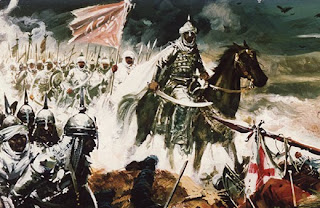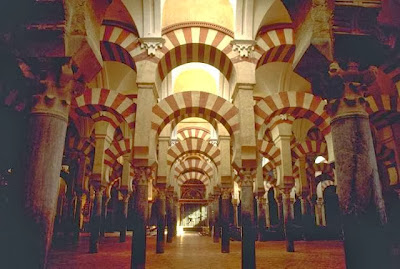Germanic Invasions
In 406 t he Iberian Peninsula was invaded by Germanic peoples consisting of Vandals, Swabians, and Alans, a non-Germanic people of Iranian stock who had attached themselves to the Vandals. Within two years, the invaders had spread to the west coast. The Swabians were primarily herders and were drawn to Galicia because the climate was similar to what they had left behind.
he Iberian Peninsula was invaded by Germanic peoples consisting of Vandals, Swabians, and Alans, a non-Germanic people of Iranian stock who had attached themselves to the Vandals. Within two years, the invaders had spread to the west coast. The Swabians were primarily herders and were drawn to Galicia because the climate was similar to what they had left behind.
The Vandals settled to the north of Galicia but soon left with the remnants of the Alans for the east. After the departure of the Vandals, the Swabians moved southward and settled among the Luso-Romans, who put up no resistance and assimilated them easily. The urban life of the citânias gave way to the Swabian custom of dispersed houses and smallholdings, a pattern that is reflected today in the land tenure pattern of northern Portugal.
Roman administration disappeared. The capital of Swabian hegemony was present-day Braga, but some Swabian kings lived in the Roman city of Cale (present-day Porto) at the mouth of the Douro River. The city was a customs post between Galicia and Lusitania. Gradually, the city came to be called Portucale, a compound of portus (port) and Cale. This name also referred to the vast territory to the immediate north and south of the banks of the river upstream from the city.
With large parts of the peninsula now outside their control, the Romans commissioned the Visigoths, the most highly Romanized of the Germanic peoples, to restore Rome's hegemony in 415. The Visigoths forced the Vandals to sail for North Africa and defeated the Swabians. The Swabian kings and their Visigothic overlords held commissions to govern in the name of the emperor; their kingdoms were thus part of the Roman Empire.
Visigoths forced the Vandals to sail for North Africa and defeated the Swabians. The Swabian kings and their Visigothic overlords held commissions to govern in the name of the emperor; their kingdoms were thus part of the Roman Empire.
Latin remained the language of government and commerce. The Visigoths, who had been converted to Christianity in the fifth century, decided to organize themselves into an independent kingdom with their capital at Toledo. The kingdom was based on the principle of absolute monarchy, each sovereign being elected by an assembly of nobles. Visigothic kings convoked great councils made up of bishops and nobles to assist in deciding ecclesiastical and civil matters.
Visigoths gradually fused with the Swabians and Hispano-Romans into a single politico-religious entity that lasted until the eighth century, when the Iberian Peninsula fell under Muslim domination.
Muslim DominationIn 711 Iberia was invaded by a Muslim army commanded by Tariq ibn Ziyad. The last Visigothic king, Rodrigo, tried to repel this invasion but was defeated. The Muslims advanced to Córdoba and then to Toledo, the Visigothic capital. The last resistance of the Visigoths was made at Mérida, which fell in June 713 after a long siege.
Toledo, the Visigothic capital. The last resistance of the Visigoths was made at Mérida, which fell in June 713 after a long siege.
In 406 t
 he Iberian Peninsula was invaded by Germanic peoples consisting of Vandals, Swabians, and Alans, a non-Germanic people of Iranian stock who had attached themselves to the Vandals. Within two years, the invaders had spread to the west coast. The Swabians were primarily herders and were drawn to Galicia because the climate was similar to what they had left behind.
he Iberian Peninsula was invaded by Germanic peoples consisting of Vandals, Swabians, and Alans, a non-Germanic people of Iranian stock who had attached themselves to the Vandals. Within two years, the invaders had spread to the west coast. The Swabians were primarily herders and were drawn to Galicia because the climate was similar to what they had left behind.The Vandals settled to the north of Galicia but soon left with the remnants of the Alans for the east. After the departure of the Vandals, the Swabians moved southward and settled among the Luso-Romans, who put up no resistance and assimilated them easily. The urban life of the citânias gave way to the Swabian custom of dispersed houses and smallholdings, a pattern that is reflected today in the land tenure pattern of northern Portugal.
Roman administration disappeared. The capital of Swabian hegemony was present-day Braga, but some Swabian kings lived in the Roman city of Cale (present-day Porto) at the mouth of the Douro River. The city was a customs post between Galicia and Lusitania. Gradually, the city came to be called Portucale, a compound of portus (port) and Cale. This name also referred to the vast territory to the immediate north and south of the banks of the river upstream from the city.
With large parts of the peninsula now outside their control, the Romans commissioned the Visigoths, the most highly Romanized of the Germanic peoples, to restore Rome's hegemony in 415. The
 Visigoths forced the Vandals to sail for North Africa and defeated the Swabians. The Swabian kings and their Visigothic overlords held commissions to govern in the name of the emperor; their kingdoms were thus part of the Roman Empire.
Visigoths forced the Vandals to sail for North Africa and defeated the Swabians. The Swabian kings and their Visigothic overlords held commissions to govern in the name of the emperor; their kingdoms were thus part of the Roman Empire.Latin remained the language of government and commerce. The Visigoths, who had been converted to Christianity in the fifth century, decided to organize themselves into an independent kingdom with their capital at Toledo. The kingdom was based on the principle of absolute monarchy, each sovereign being elected by an assembly of nobles. Visigothic kings convoked great councils made up of bishops and nobles to assist in deciding ecclesiastical and civil matters.
Visigoths gradually fused with the Swabians and Hispano-Romans into a single politico-religious entity that lasted until the eighth century, when the Iberian Peninsula fell under Muslim domination.
Muslim DominationIn 711 Iberia was invaded by a Muslim army commanded by Tariq ibn Ziyad. The last Visigothic king, Rodrigo, tried to repel this invasion but was defeated. The Muslims advanced to Córdoba and then to
 Toledo, the Visigothic capital. The last resistance of the Visigoths was made at Mérida, which fell in June 713 after a long siege.
Toledo, the Visigothic capital. The last resistance of the Visigoths was made at Mérida, which fell in June 713 after a long siege. In the spring of 714, a Muslim army commanded by Musa ibn Nusair marched to Saragossa and then to León and Astorga. Évora, Santarém, and Coimbra fell by 716. Thus, within five years, the Muslims had conquered and occupied the entire peninsula. Only a wedge of wet, mountainous territory in the extreme northwest called Astúrias remained under Christian control.
In Lusitania land was divided among Muslim troops. However, bad crops and a dislike for the wet climate put an end to the short-lived Muslim colonization along the Douro River. Muslims preferred the dry country below the Tagus River because it was more familiar, especially the Algarve, an area of present-day Portugal where the Muslim imprint remains the strongest.
The Muslim aristocracy settled in towns and revived urban life; others fanned out across the countryside as small farmers. The Visigothic peasants readily converted to Islam, having only been superficially Christianized. Some Visigothic nobles continued to practice Christianity, but most converted to Islam and were confirmed by the Muslims as local governors. Jews, who were always an important element in the urban population, continued to exercise a significant role in commerce and scholarship.
 |
| Muslim Army |
Al Andalus
Al Andalus, as Islamic Iberia was known, flourished for 250 years, under the Caliphate of Córdoba. Nothing in Europe approached Córdoba's wealth, power, culture, or the brilliance of its court. The caliphs founded schools and libraries; they cultivated the sciences, especially mathematics; they introduced arabesque decoration into local architecture; they explored mines; they developed commerce and industry; and they built irrigation systems, which transformed many arid areas into orchards and gardens. Finally, the Muslim domination introduced more than 600 Arabic words into the Portuguese language.
The Golden Age of Muslim domination ended in the eleventh century when local nobles, who had become rich and powerful, began to carve up the caliphate into independent regional city-states (taifas), the most important being the emirates of Badajoz, Mérida, Lisbon, and Évora. These internecine struggles provided an opportunity for small groups of Visigothic Christians, who had taken refuge in the mountainous northwest of the peninsula, to go on the offensive against the Muslims, thus beginning the Christian reconquest of Iberia.
Arab culture in Peninsula
Society and demographics. Aspects of everyday life
The population of Al-Andalus was very heterogeneous and consists of Arabs and Berbers (and some other Muslims), Mozarabic (Spanish-Goths are that under Muslim rule retained the Christian religion-Mozarabic rite, but adopted the ways of life foreign Muslims) and Jews. Besides these, there was another group, the muladis, who were Christians who had converted to Islam.
The Mozarabic and the Jews freedom of worship, but in exchange for this freedom were required to pay two taxes: the personal tax capitation (Gizia), and property tax on income of land (carage). These two groups had their own authorities, enjoyed freedom of movement and could be judged according to their right.
Public baths
In rural and urban public baths existed (hammam), which functioned not only as places of hygiene, but also for socializing. The Islamic baths had a structure inherited from the Roman baths, with several rooms with cold water pools, warm and hot.
Them worked masseurs, barbers, having custody clothes, makeup artists, etc.. The morning was reserved for men and women in the afternoon. With the Christian reconquest many of these baths were closed to be understood that they were amenable to local political conspiracies, as well as sexual intercourse.
Feeding
Bread was the staple diet of al-Andalus, also consuming meat, fish, vegetables and fruits. The foods were cooked with the use of herbs such as "oregano", rosemary and peppermint (the latter is also used in tea) and spices (ginger, pepper, cumin ...). The fat used was olive oil (az-zait), where the one produced in the region of Coimbra was famous.
The sweets were also appreciated, as cheesecakes (qayyata), rice pudding covered with cinnamon and various pastries made with dried fruit and honey, which are still characteristic of the cuisine of certain regions of the peninsula.
Economy
The arrival of Islamic civilization to the Iberian peninsula would cause major economic. An essentially rural economy went up for a markedly urban economy.
One of the most important Muslim city is the suq or market. The markets would know a renaissance in the peninsula during the Islamic period. Them performed up trade in various products, mainly of metal products and other handicraft products. The workshops and tents of al-Andalus, where they produced these works were owned by the state. The main products of trade were silks, cotton, wool fabrics. Some luxury items produced in the al-Andalus would be exported to Christian Europe, and even to the Maghreb to the Middle
 |
| Mosque of Cordoba |
Arab culture in Peninsula
Society and demographics. Aspects of everyday life
The population of Al-Andalus was very heterogeneous and consists of Arabs and Berbers (and some other Muslims), Mozarabic (Spanish-Goths are that under Muslim rule retained the Christian religion-Mozarabic rite, but adopted the ways of life foreign Muslims) and Jews. Besides these, there was another group, the muladis, who were Christians who had converted to Islam.
The Mozarabic and the Jews freedom of worship, but in exchange for this freedom were required to pay two taxes: the personal tax capitation (Gizia), and property tax on income of land (carage). These two groups had their own authorities, enjoyed freedom of movement and could be judged according to their right.
Public baths
In rural and urban public baths existed (hammam), which functioned not only as places of hygiene, but also for socializing. The Islamic baths had a structure inherited from the Roman baths, with several rooms with cold water pools, warm and hot.
 |
| Arab public baths |
Them worked masseurs, barbers, having custody clothes, makeup artists, etc.. The morning was reserved for men and women in the afternoon. With the Christian reconquest many of these baths were closed to be understood that they were amenable to local political conspiracies, as well as sexual intercourse.
Feeding
Bread was the staple diet of al-Andalus, also consuming meat, fish, vegetables and fruits. The foods were cooked with the use of herbs such as "oregano", rosemary and peppermint (the latter is also used in tea) and spices (ginger, pepper, cumin ...). The fat used was olive oil (az-zait), where the one produced in the region of Coimbra was famous.
 |
Cheesecakes (qayyata) of Sintra |
Economy
The arrival of Islamic civilization to the Iberian peninsula would cause major economic. An essentially rural economy went up for a markedly urban economy.
One of the most important Muslim city is the suq or market. The markets would know a renaissance in the peninsula during the Islamic period. Them performed up trade in various products, mainly of metal products and other handicraft products. The workshops and tents of al-Andalus, where they produced these works were owned by the state. The main products of trade were silks, cotton, wool fabrics. Some luxury items produced in the al-Andalus would be exported to Christian Europe, and even to the Maghreb to the Middle


Sem comentários:
Enviar um comentário